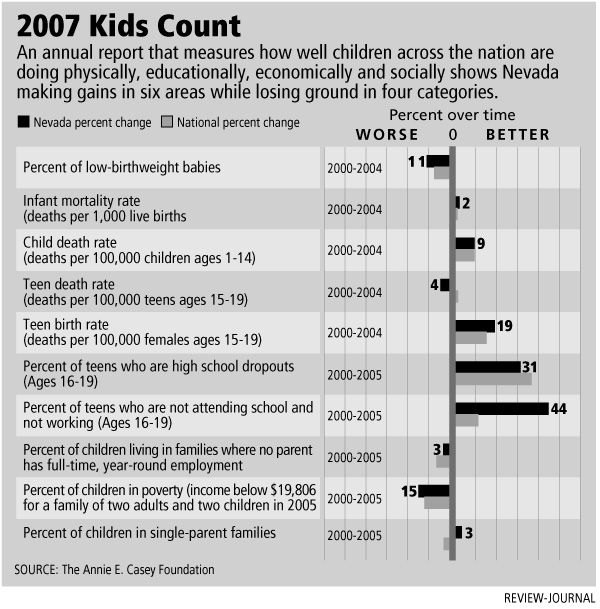State’s youth trends rated
The trends highlighted in a national review of child well-being show Nevada youth teetering on a slippery statistical slope.
The grease under their feet: tightening economic conditions.
According to the latest Kids Count data book released today by the Annie E. Casey Foundation, the number of Nevada children living in poverty increased by 15 percent between 2000 and 2005, the most recent year included in the study. Nevada's median family income in 2005 was $52,000, $1,000 below the national median income.
At the same time, 71 percent of low-income families in Nevada spent more than 30 percent of their income on housing. That makes Nevada one of the 10 most expensive states for low-income families said Laura Beavers, the Casey research associate who oversaw production of the 2007 Kids Count data book.
"To a lot of people in the country, that will come as a surprise," Beavers said Tuesday. "A lot of people still think Nevada is affordable."
In both Nevada and the United States, the median family income, when adjusted for inflation, purchases less now than it did five years ago, Beavers said.
"On the economic side, it's something we should be sounding bells about," Beavers said. "Whatever economic recovery we have now, it's not trickled down. It's not a true economic recovery for kids."
And when family finances are tight, it affects other indicators, Beavers said. That's evidenced by the percentage of children who in 2004 had no health insurance -- 16 percent in Nevada and 11 percent for the nation.
The latest Kids Count report, which uses data gathered from numerous government resources, ranks Nevada at 33 when it comes to the overall state of 10 child welfare indicators. That's a slight improvement from its 36th place ranking in 2006, a gain assisted by decreases in the number of teens giving birth and the child mortality rate.
The state's poorest showing was its high school dropout rate. At 11 percent in 2005, the rate among teens in Nevada was the worst in the nation, the report found. The national average in 2005 was 7 percent.
"Nevada has certainly improved its dropout rate," Beavers said. "But that is certainly one of the issues with Kids Count. If every state is making major strides and everyone is doing something more, the ranking for an individual state isn't going to change."
Nevada State Board of Education Member Jan Biggerstaff has watched public schools struggle with the dropout problem for years. Nevada has shown improvement, the report found: Between 2000 and 2005, Nevada was able to lower the teen dropout rate. But Biggerstaff believes that the key is a change in how school is perceived. It's not something you leave in order to take a job, he said. It's not a place to be until you're legally free to leave.
"We've got to get these kids to see that education is a tool to better their lives," he said.
Kids Count also found that Nevada has a higher rate of children in foster care than the U.S. does as a whole. In 2004, 12 of every 1,000 Nevada children under the age of 18 were in foster care. That's about 7,368 children. The national rate was 10 per every 1,000 children.
The figure concerns Casey Foundation President Douglas Nelson, who wrote in an essay that accompanied the report: "Permanent family relationships are critical to the healthy development of children everywhere."
Nelson gets no argument from Clark County Family Services Director Tom Morton. Among Morton's primary goals are reducing the number of children removed from their homes and increasing the number of available foster families in the system.
Both are challenging tasks, Morton said Tuesday. Even though Nevada as a state emphasizes family reunification, intervention services like adult mental health services, domestic violence counseling and substance abuse programs are not readily available. Some improvements were made in the last legislative session, Morton said, but they were not equal to the need.
"I think that many in the community would agree that the safety net for families in Nevada has some gaping holes in it," he said. "Affordable day care, affordable housing, affordable transportation, anything of that nature is a problem here and that increases the likelihood of child maltreatment."
Morton is still working on recruiting foster families, a need that's always pressing within his agency. Gains have been made, he said, but will continue only if the community sees the protection of children as a duty shared by everyone.
"I think we're making headway," Morton said.

















